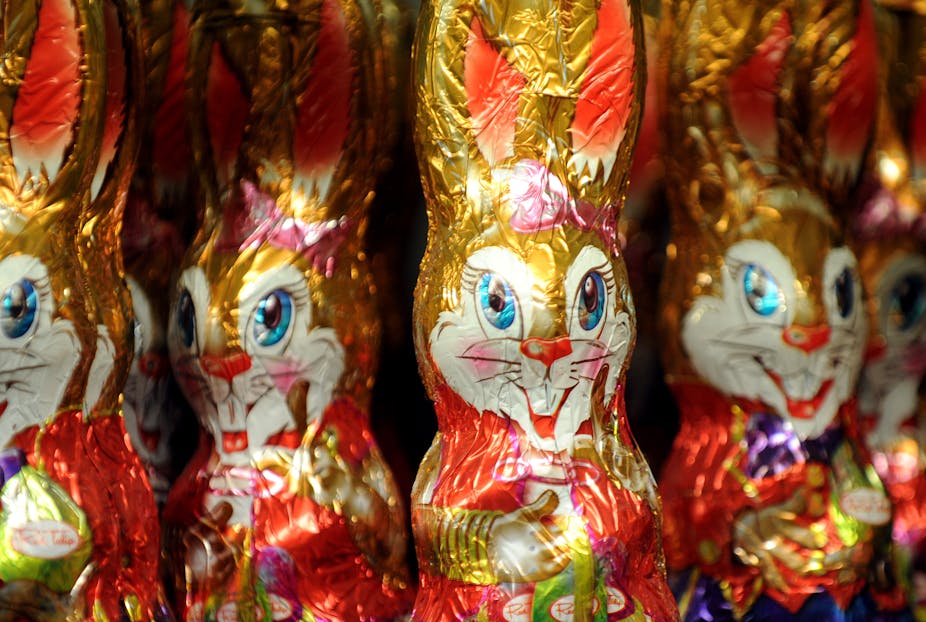This Easter it is worth asking what the Easter Bunny is all about. Indeed, there’s more to the furry character than a fondness for chocolate.
Rabbits were first domesticated by monks in the south of France, sometime after 500 AD. This enabled the avoidance of a papal decree prohibiting the eating of red meat during Lent (the six week period before Easter).
New-born rabbits, surrounded by fluids, were conveniently regarded as fish. But it didn’t stop there. Beavers and tortoises, because of their obvious aquatic habits were also fair game. Barnacle geese, winter migrants in northern France, were believed to begin life under water as barnacles. Being “not born of flesh”, they were also eaten during Lent in some monasteries. Other monks considered this practice immoral.
Rabbit keeping eventually attracted wider attention. Norse adventurers and warriors, established along the River Seine, provided the next critical element. Granted land for service as mercenaries they took Frankish wives and adopted the cultural elements of the time: linguistic, culinary and agricultural. Transformed to Normans, they dominated not only northern continental Europe but subsequently conquered Britain and expanded agriculture and introduced new livestock including rabbits.
Rather than being the speciality of monks who broke bread and drank wine, rabbit keeping was suddenly in the hands of entrepreneurs who preferred beer and grain porridge. Furthermore, although domestic rabbits were still kept, more flavoursome, gamey rabbits could be raised. Garennes, essentially areas of pasture, were set aside and surrounded by stone walls, or even moats, to confine the rabbits and deter predatory stoats and foxes. This was done under sovereign right in feudal times and only the most privileged nobility had a garenne on their estates.

The well-conserved 13th century Garenne d’Anneville on the island of Guernsey provides an example of the way the garennes in continental France must have functioned. It is an open grassy area of about a hectare where rabbits still burrow in a well-drained sandy rise covered with gorse and blackberries encircled by a moat once stocked with carp. It provided rabbits and fish for the Manor des Annevilles nearby.
In Britain, at the same time, warreners built burrow-like structures for rabbits with high surrounding walls. A similar culture was also well developed in coastal Holland by 1400. The coastal dunes were managed as warandes by duinmeiers who produced an abundance of rabbits by constructing artificial burrows, providing hay in cold winters and controlling foxes, cats and polecats.
Eventually, however, the importance of garennes and warrens declined. Jean I of France, for example, on seeing the need for more intensive agriculture, forbade the creation of new garennes in the 14th century and other social forces eventually saw the abandonment of garennes, leaving rabbits to run wild in areas they had never naturally occupied before.
French hunters still call the wild rabbit “le lapin de garenne” even today. The link between rabbits and Easter has likewise continued despite the twists and turns in the fortunes of monks, kings and warriors.
On seeing La Garenne d’Anneville, any Australian biologist would have a sense of the inevitability about subsequent events. With the European colonisation of Australia it was little wonder that rabbits, carp, black-berries and gorse came too; they were by then programmed into the world picture of our forebears. All four species notably became serious pests in Australia and subject to costly biological control programs by CSIRO and state pest control organisations.
Yet, despite the hard work to resolve such problems, many Australians still remain oblivious of the economic and environmental threats posed. Rabbits in particular are widely regarded a cute and cuddly pets rather than pests, again reflecting European tradition; an imported Beatrix Potter view rather than a more objective look about.
Indeed, this is why the idea of the Easter Bilby has been promoted. It challenges an unthinking acceptance of rabbits when they remain major economic and environmental pests in an Australian context. And despite criticism that it is contrived or neglects social history, the Easter Bilby concept has gained considerable traction.

Easter Bilbies of the finest chocolate are produced by Haigh’s Chocolates in Adelaide and a percentage from each sale is invested through Rabbit-Free Australia to find ways of reducing rabbit impact on native wildlife. Likewise, Kaye Kessing and Ali Garnett from Alice Springs produced two children’s books about the Easter Bilby to highlight the plight of native arid-zone animals in the face of competition and predation by introduced animals.
Although it is an interesting part of our social history, the Easter Bunny’s origins may be as socially contrived as any promotion of the Easter Bilby, simply to allow the eating of red meat during Lent.
More importantly, we should ask whether those Australians who retain ideas most appropriate to the Old World will ever begin thinking about, and caring for, an equally interesting but completely different continent.

